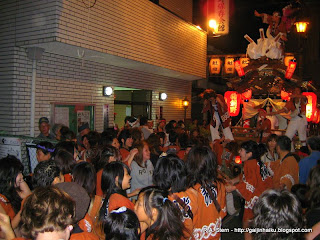Nestled in a place called Momodani is Miyukimori Shrine, home to the tutelary deity of the area formerly called Ikaino Village. By some accounts, the famous 4th century Emperor Nintoku is also a diety of the shrine, and is an important part of the historical flavoring of Ikaino. A mixed history of native descent, Korean immigration, and bureaucratic re-organizations have changed maps, place names and even moved entire rivers in this place. Today the remnants of Ikaino Village persist as traditions through the Ikaino Preservation Society, and the word Ikaino has since gained multiple meanings from its winding history (course lecture, Dr. J. Hester, Kansai Gaidai).
Miyukimori Shrine
Miyukimori Shrine and the Ikaino Preservation Society have a relationship that blurs the lines of secular and religious1. To the Western mind these terms are mutually exclusive categories, a tendency that is as problematic as it is helpful. The role of Shinto shrines in Japanese life, however, is integral. Neighborhood solidarity, individual religious needs, record keeping, and annual Shinto rights are but some of the many roles a shrine attends to for Japanese society.
This annual festival is held throughout Japan celebrating 3, 5, and 7 year olds.
Although performed as Shinto ritual, it is not necessairly consider a religious practice by those who attend.
While the Ikaino Preservation Society concerns itself mostly with tradition, it relies upon the Miyukimori (and other purely secular institutions) for maintaining everyday neighborhood connections, and also utilizes it as the nexus for traditional displays such as the aki matsuri (Fall festival). The shrine complex provides storage for the danjiri (the large portable shrine which itself transports the shrine deity around the neighborhood), space for festival merchants, and priests for religious rights and prayers. The interactions of individuals with the shrine are often transparent, perhaps seen in a hitherto glimpse as someone is seen praying at the offering box during matsuri, or anytime it is appropriate to daily life. Their association with the shrine, however, is far more public as Japanese shrines serve geographically bounded parishes, sometimes including multiple neighborhoods.
The danjiri stops outside the Preservation Society headquarters.
Neighborhood solidarity is displayed prominently through happi coats worn by participants.
Although the Western penchant for separating the secular and religious can often cause difficulty in understanding how the Japanese view their own relationship to the shrine, we ought to recognize parallels. Historically in the US and Europe alike, Christian churches served geographical parishes uniting communities around religious centers. US constitutional doctrine aside, I find it no far reach to imagine Western thought once being very much without these rigid categories. I wonder just how much the US separation from England has influenced this contemporary mode of thinking around the world, and where are we taking it in the future.
1: For more discussion on ritual in everyday life in Japan see Ian Reader, Ceremony and Ritual in Japan.




One response to “Religion & Tradition: A Blended Perspective”
You do very well covering important aspects of Japanese religion by starting with a specific shrine with a complex history to say the least, commenting on Japanese religion itself and then offering a thought provoking cross cultural comparison. Oh so much in a pithy blog post - excellent.
Post a Comment